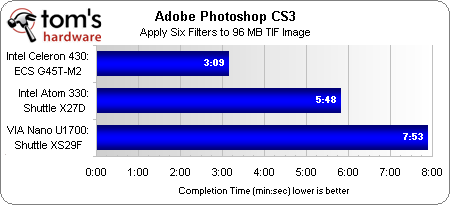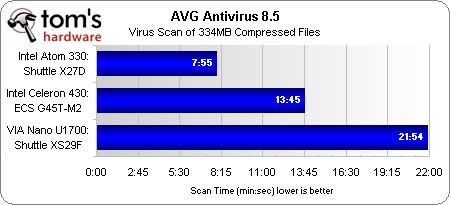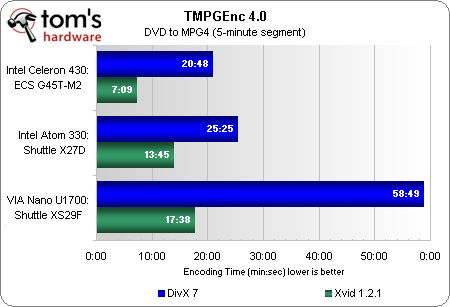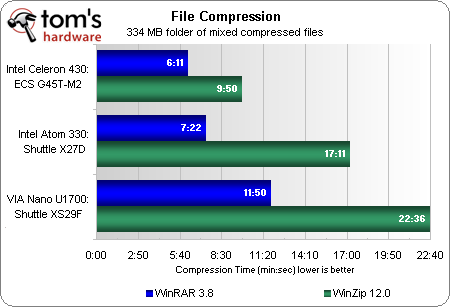Shuttle XS29F: Is VIA's Nano Processor Powerful Enough?
Benchmark Results: Applications
We tried to limit today’s benchmarks to applications that are used in a typical office environment, such as word processing, Web browsing, and database management. But because the benchmark we use for checking MS Office and Internet Explorer performance isn’t compatible with the Chrome9 HC3 graphics driver of the VIA Nano platform, we were forced to chose the most “office friendly” benchmarks from our high-end system test set.
Anyone working with 96MB TIF images probably calls his or her office a studio, so the traditional office tasks of resizing or cropping an image don’t take nearly this long. On the other hand, those who already experience operational delays when using traditional desktop processors would probably find even less performance unacceptable.
Recent versions of AVG anti-virus appear extremely friendly towards multi-core processing, giving the Atom 330 a substantial performance lead over the single-core Celeron 430. The Nano U1700’s slow single core is poorly suited to the task.
Video conversion isn’t the most common office application, but we have seen downsized videos attached to organizational newsletters. A marginal lead in DivX and a much larger lead in Xvid favor the single-core Celeron, while the dual-core Atom is still significantly faster than the Nano.
WinRAR almost perfectly reflects CPU clock speed, rather than architecture, while WinZip appears optimized towards the desktop CPU.
Get Tom's Hardware's best news and in-depth reviews, straight to your inbox.
Current page: Benchmark Results: Applications
Prev Page Test Setup And Benchmark Configuration Next Page Benchmark Results: Synthetic-
Wouldn't this just be a linux-only machine then? I can't possibly see any other use for it other than maybe a childs pc or a general "Internet & Email only" PC.Reply
-
pakardbell486dx2 This may be a dumb question, but why was Xp not used for this test? Clearly "just barely" wont work for people who spend their hard earn money on something like this. Maybe the celeron is ok for vista basic but the atom and nano platforms are just not good enough for Vista. If I can make an analogy comparing Vista and Atom/Nano it's like an old 73' Corolla trying to haul ten tons uphill.Reply -
tacoslave amd huron platform thats all i have to say i want to see it benched see how it stakes up.Reply -
Blueridge I agree that the major drawback of this review is the use of Microsoft Vista. I think that Windows XP Home edition for ULPC or a netbook spin of a linux distro (e.g. Ubuntu) would have been a much better choice for this review, especialy since is very well known that Vista is just not the right choice for netbooks (or nettops). Some time ago I read several reviews of the nano processor, based on Win XP and they performed more than OK, they were even suitable for a small HTPC at that time (the toughest challenge was DVD playback back then) and with a better chipset would have performed even netter. But this happens when a resource hungry OS like vista is used... just my 2 cents.Reply -
HalfHuman i guess a windoze xp or 7 would be a lot better to use with this kind of hardware. in fact i cannot think at a more inapropriate os to run on a nentop than vista. :)Reply
maybe the performance delta would be the same but the usability would be more than "acceptable".
regarding the "benchmarking" stuff... i do not think that anybody sane would buy a nettop to use it for hardcore photo editiing or transcoding.
if i'd buy a nettop i'd be interested in several factors:
- to be powerfull enough for office work and maybe hd playback
- to use as little power as possible (which nano does nicely) as this kind of device would be rarely powered down
- to be silent (which nano is)
i think that performance per watt is irrelevant here as a system like this is not meant to be "performant". i think that the one that uses less watts, has more features is queter wins here.
my take on this is that via has a very nice platform and nano wins even if it's not the fastest. -
Blueridge I just took a look at Via's website and it seems that Nano is available in flavors up to 1.8GHz. I wish a machine based on such a processor was used for this review, though I think the main issue here is availability.Reply -
HalfHuman i would be nice to see some noise evaluations, some hd playback tests... some appropriate os. :)Reply -
eddieroolz The Nano would be the perfect computer to just leave it powered on, seeding torrents and such.Reply




